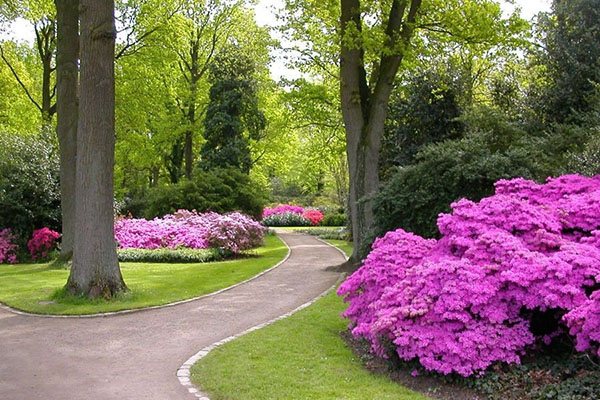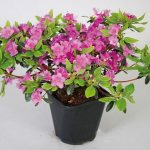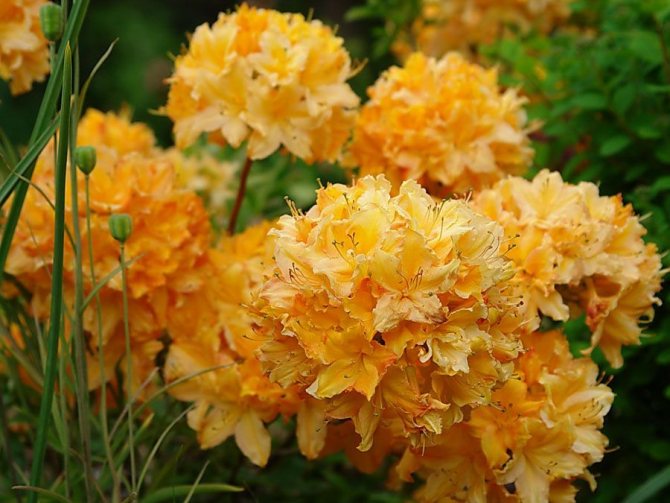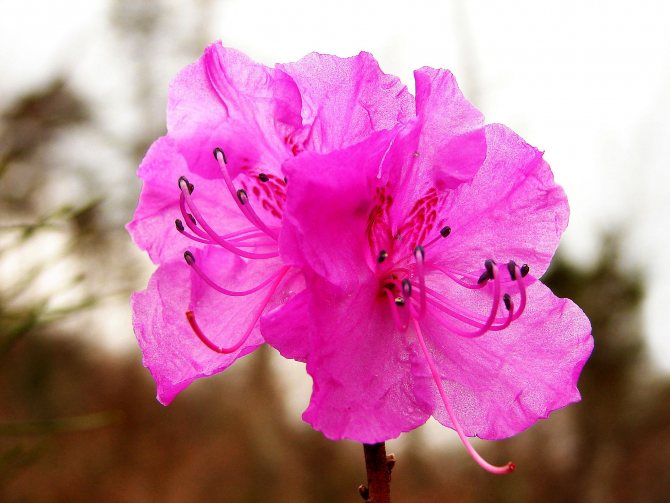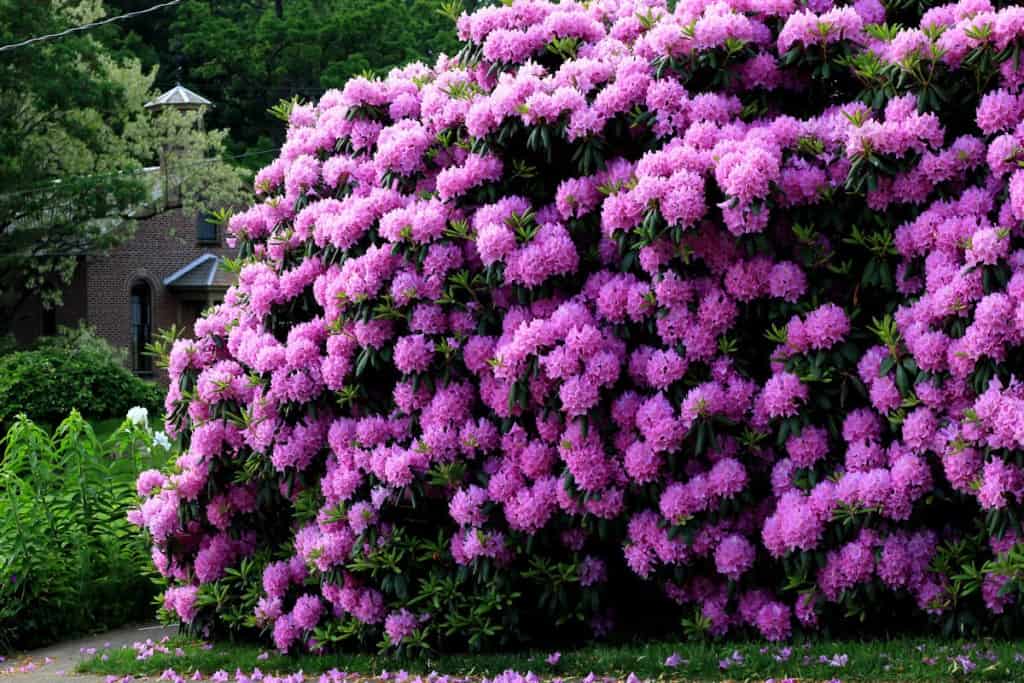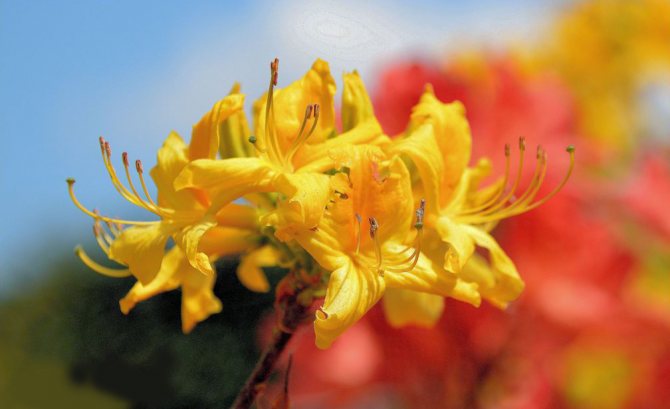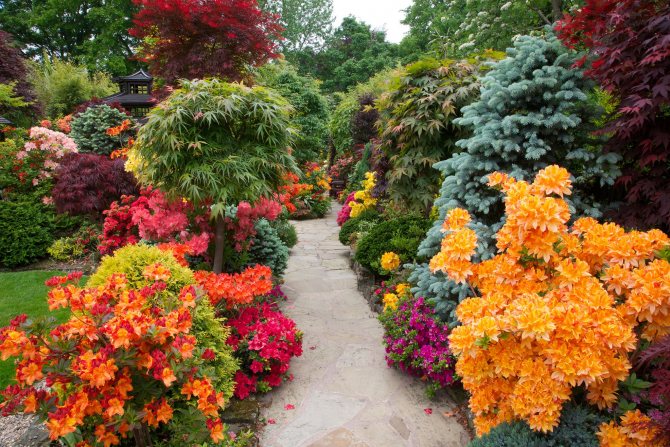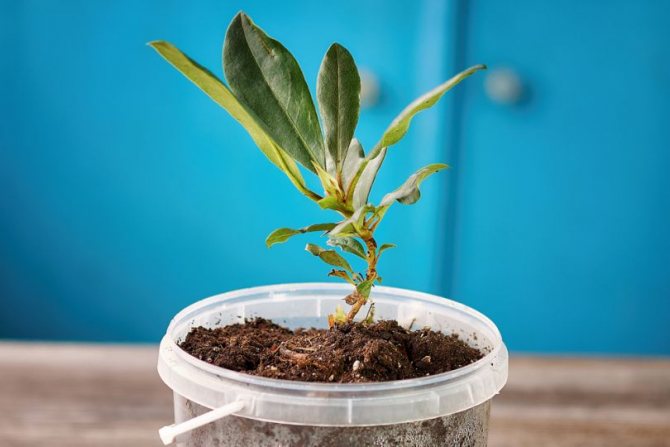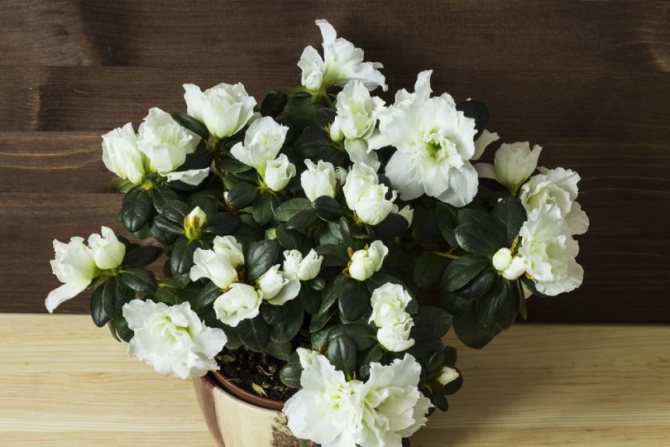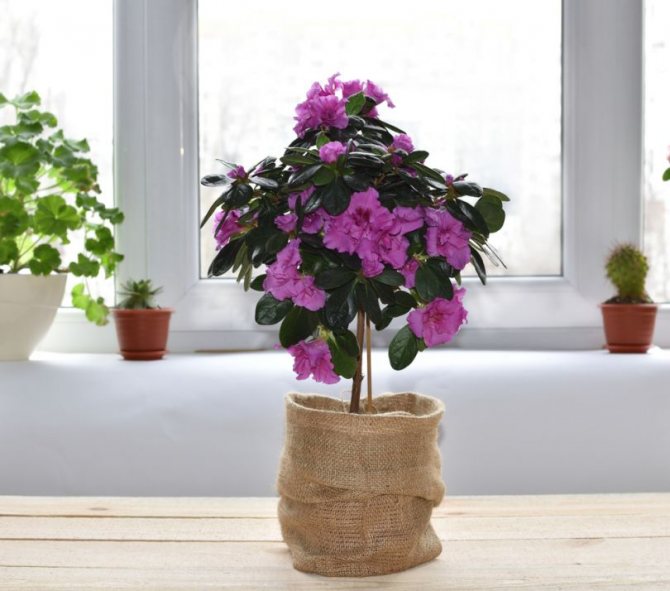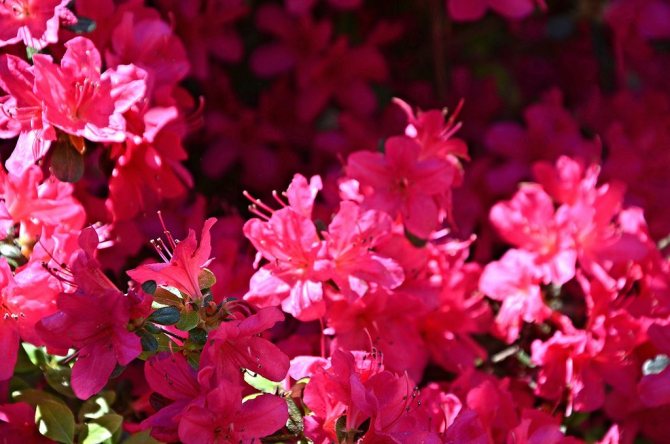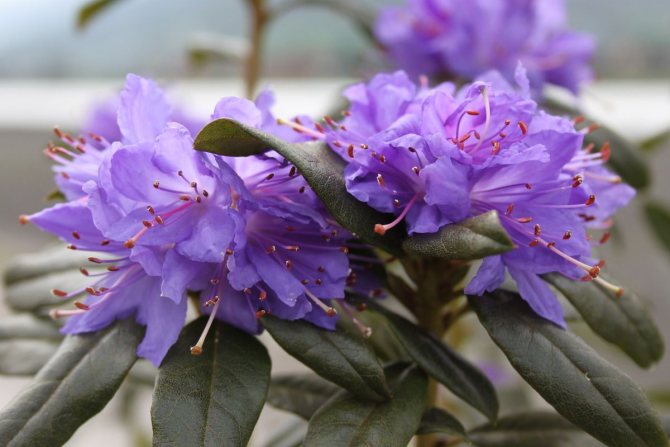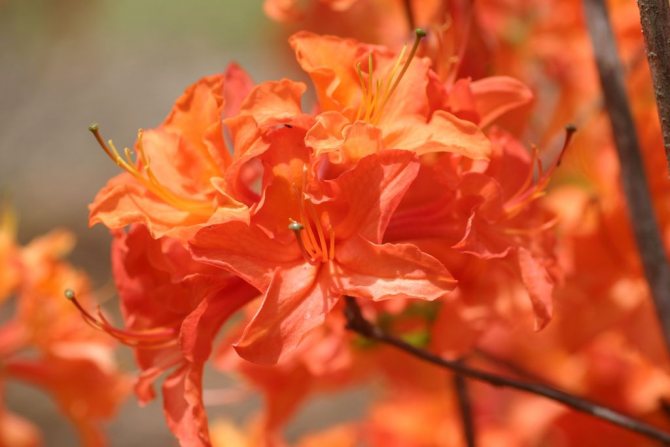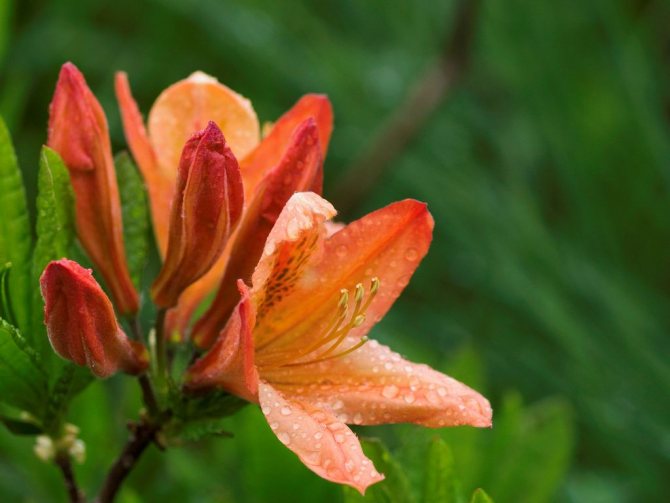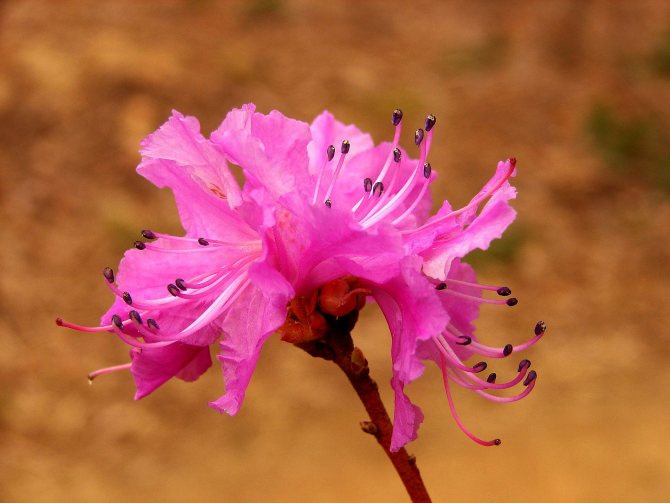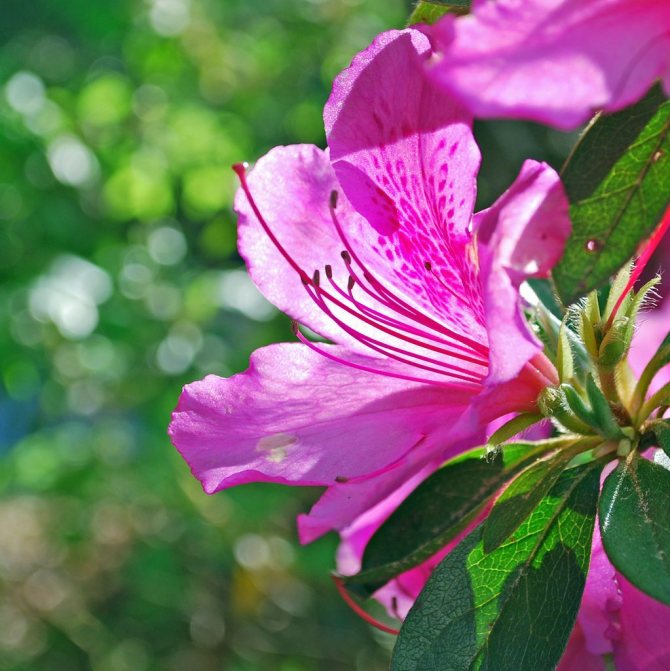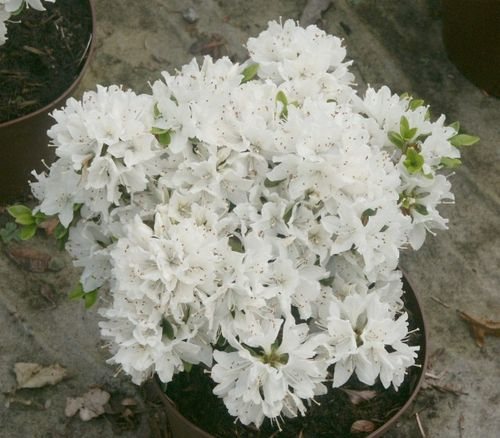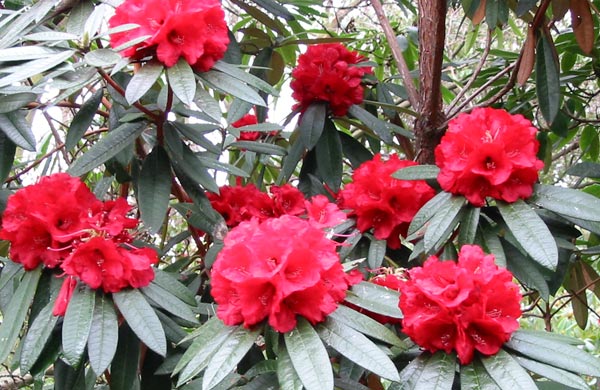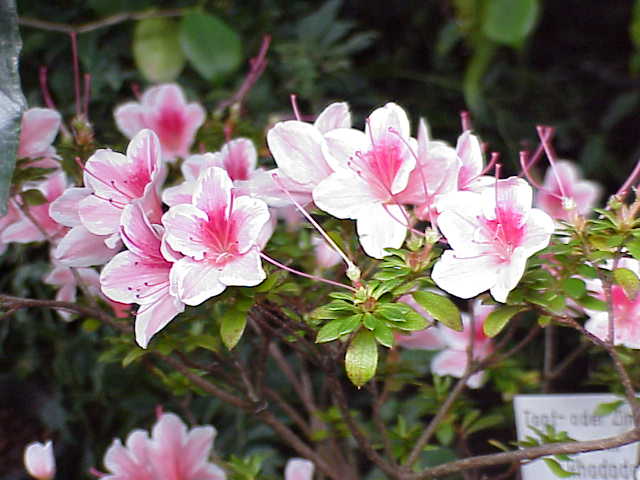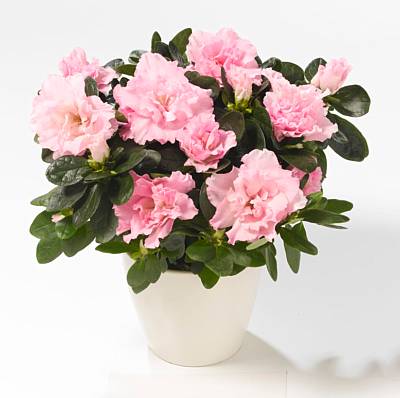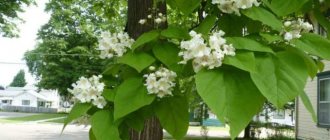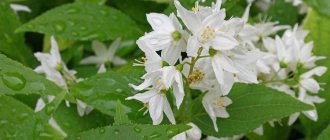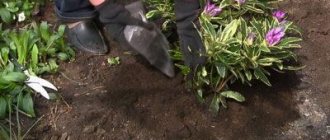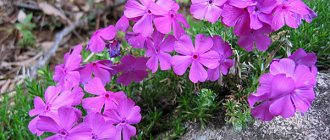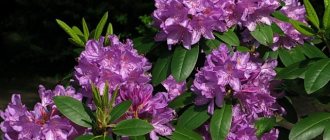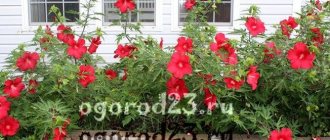Today there are a huge number of different decorative cultures that are widely used in modern landscape design. The most popular is the rhododendron or rose tree, as many gardeners call it.
This ornamental plant simply amazes with its bright appearance and lush flowering. There is an opinion that this exotic shrub cannot be grown in the climate of the Urals, but this is absolutely not the case. Today, a huge number of fairly cold-resistant and frost-resistant species and varieties of rhododendron have been created, which, with proper care and adherence to all planting rules, you can grow in the Urals.
In this article, we will take a closer look at the features of rhododendron, and also note the types and varieties of this culture that can be grown in the Urals. We will also tell you about the most important nuances of agricultural technology for growing rhododendron in the Urals.
Rhododendron, she is azalea: the transcendent beauty of a foreign capricious
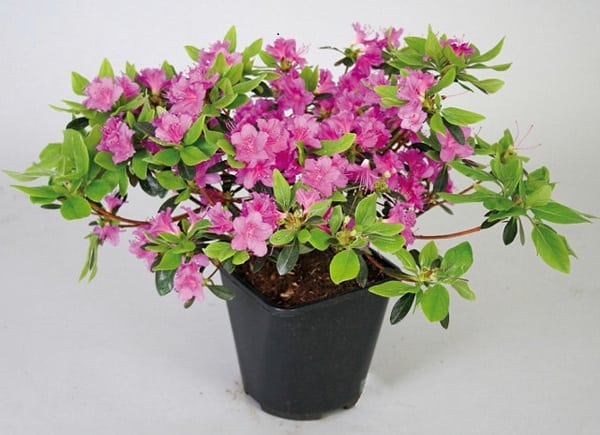
On the one hand, azalea flowers are second to none. On the other hand, having brought a flowerpot from the store and starting to take care of it, some growers notice that either due to stress (moving), or due to improper care, the plant begins to exponentially lose flowers. But don't let that stop you! Surrounding the flower with proper care, you will definitely achieve its "location".
This evergreen bush was brought to us from Asia (China, Japan). There are many garden forms of rhododendron, but in apartments and houses we grow only two types of azaleas:
- Indian. It blooms in winter, the flowers are large (up to 5 cm), the bush grows to half a meter, the leaves are covered with reddish hairs.
- Japanese. A shorter plant with shiny leaves. The flowers of such a rhododendron are smaller than those of its previous brother, but it is not so picky - in the summer it can even grow in the garden.
Blooms only an adult plant (from 3 or even 4 years old). Depending on the variety, the petals can be deep pink (the most common shade), lilac, purple, white, scarlet, less often two-colored. The photo shows that the rhododendron blooms in both even and double flowers.
Interesting Facts
A few facts that the rhododendron really won the hearts of plant lovers:
- It is called not only an azalea, but also an alpine or English rose.
- There are varieties with flowers up to 20 cm in diameter.
- Rhododendron is a medicinal plant used in folk and traditional medicine. The main 4 species with healing properties: golden, Caucasian, Sagan-daila and Daurian rhododendrons. In the traditional medicine of Tibet, the plant is anti-inflammatory and antifungal, as well as a tonic. Leaves, flowers and stems are used.
- In different countries there is a unique culture of growing rhododendron. So, in India, meter lush flowers are cultivated. And in Japan, a whole trend in the art of bonsai appeared - the formation of amazing trees from rhododendron bushes.
- Rhododendron in the wild is an early spring honey plant.
- Some growers are sure that the plant in the house has its own symbolism.Rhododendron has a powerful positive energy, maintains harmonious relationships in the family, restores mutual understanding after minor quarrels. It is recommended to cultivate people with increased fatigue, sleep problems.
Growing rhododendron both at home and in the garden is not an easy task, but an exciting one. The sake of chic lush buds is worth the work. With proper care, azalea becomes an adornment of any room. Blooming rhododendron in the house is a sign of the high skill of the florist.
Planting an indoor flower
Priming... This ornamental crop prefers acidic soil, which values are from 4 to 4.5 ph. This can be found on sale.
Homemade soil recipe for indoor rhododendron: 1 part sand + 1 part moss + 2 parts rotted needles.
Pot... Buy a shallow pot, as the roots of the flower need to be near the surface of the soil. A prerequisite is drainage holes from the bottom of the pot.
Transfer
The rhododendron is transferred to a new pot after the first flowering. One "relocation" a year is enough for a young plant, for a more mature plant - once every three, or even four years.
Transplant using the method transshipmentwithout shaking off the soil from the roots at all. Treat the roots as carefully as possible, they are very delicate and sensitive.
During this procedure, it is advisable to carry out a sanitary "haircut" of the flower, removing dried flowers and dried twigs.
Reproduction
Rhododendron reproduces seeds, but this method is considered difficult and time-consuming.
If you have had a bush for a long time, you can propagate it during transplantation, dividing.
But the most popular breeding method for this beautifully blooming culture is considered grafting... The cuttings should be stem, semi-lignified, about 6 cm long, with visible buds. Cut them in late spring or summer.
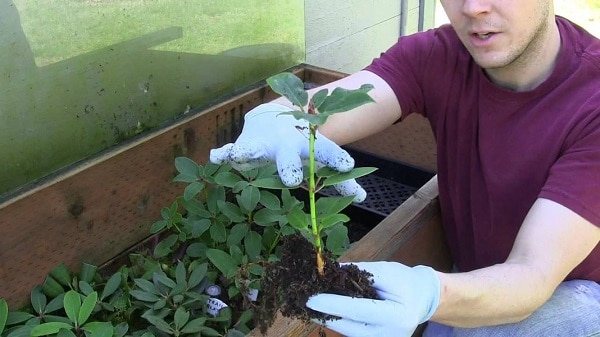

- Plant the cuttings in a pot of soil. Cover the top with a transparent jar or tray, or simply stick a pair of long pencils on the sides and attach the bag to them.
- Raise the greenhouse from time to time to water and / or spray the plant.
- Seeing that the cutting is growing flower buds, do not let it bloom - its main task is to take root, let it spend all its energy on it. And remove the kidneys (pinch off).
- The twigs take root for several months. Seeing that the stalk is already living its own life with might and main, transplant it into a personal pot. You can pinch the extended branches immediately.
You can see a good example of rooting azalea cuttings in peat tablets here:
common data
Mostly rhododendrons grow in the temperate climatic zones of the Northern Hemisphere, some species, including Thompson's rhododendron, are found in the Himalayas, China, Southeast Asia and North America, Australia and New Guinea. In the vastness of Russia, you can see about 18 species of rhododendron, mainly in the Caucasus and the Far East.
Various types of rhododendrons are represented in nature by plants of various shapes and structures - some grow up to 30 meters in height and have flowers with a diameter of more than 20 cm, others are undersized, creeping shrubs with small flowers.
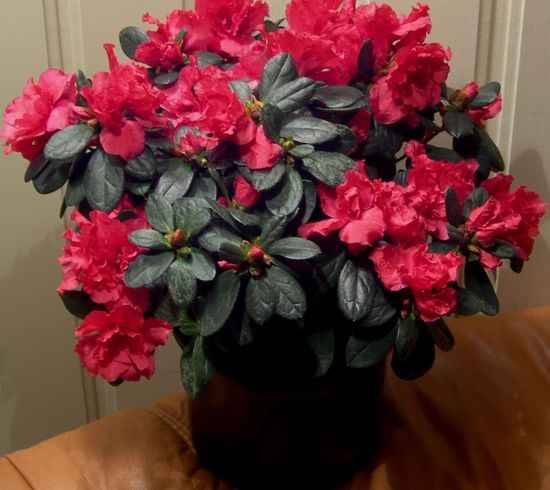

Under natural conditions, rhododendron grows singly or in whole thickets. Prefers moist soils without stagnant water, but can grow on mountain slopes. He loves high air humidity and shaded places, but it also grows in areas open to the sun.
Basic principles of caring for an adult rhododendron
- Lighting... Bright, but diffused light or partial shade is suitable for the flower. It is ideal to keep it on the east or west windowsill, but you can also put it on the northwest one. In autumn and winter (namely, from October to November), the plant grows buds and needs long-term lighting.Therefore, either keep the rhododendron in a constantly lit room, or buy a backlight for it.
- Temperature... The good news is that indoor rhododendrons don't need greenhouse heat. He feels good at 15-18 degrees, and during the budding period, keep it at 10-12 degrees. In the summer, try to keep the house no higher than 20 degrees. If you don't have air conditioning, put the flower pot on the balcony (naturally, not in the sun) or an open veranda.
- Humidity... The flowerpot likes periodic spraying, and it is good if the water in the spray bottle is cool. But spray only on leaves, not flowers. In winter, keep the azalea on a pallet of wet expanded clay, otherwise it will begin to suffer from the air dried by radiators.
- Watering... The soil in the pot should not dry out (especially when flowering). But if the pot is in a cold room, still let the soil dry, and only after 2 days carry the watering can. And in the summer it is dangerous to pour a flowerpot. Plant rhododendron only in pots with lower containers and a tray, from where you will always drain the liquid. Leave the tap water in an open vessel for at least a day. Add a couple of drops of lemon juice to your irrigation water twice a month.
- Food... Buy mineral fertilizer for rhododendron. It is imperative that it is free of chlorine. For this worthy flower, they even created a special mixture "Azalea". In the spring and summer, spoil the flowerpot with it once a week, and in the winter - once a month. During the budding period (remember, this is the end of winter or spring), buy a “delicacy” for the bush with a high content of phosphorus and potassium. A good solution is Kemira-Lux or Uniflor-Bud.
- Pinching... The growing stems are pinched at the top so that they branch and the bush grows more luxuriantly.
- Pruning... Beginning in May, prune the stretching shoots. 2-3 weeks after such a procedure, new leaves will begin to look out of the cut area.
An archival moment! All parts of the flower are poisonous... Do any trimming with gloves!
Flowering and dormant periods
Blooms this decorative culture from March to June. Some early species open their first flowers in late December, and later varieties in mid-May. In any case, flowering lasts a month and a half.
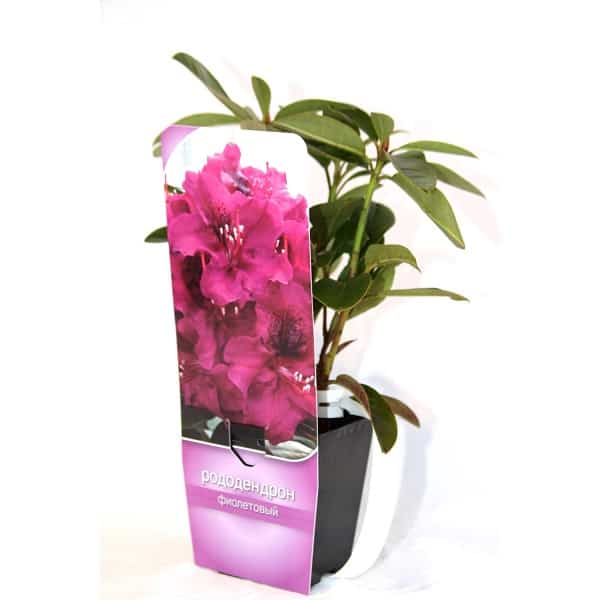

Blooming azaleas are more often offered in stores. Do not be afraid to buy them - although the flower is capricious, it tolerates moving during the flowering period well. The main thing is to check if the last flowers are on the bush - ideally, they should be the first, against the background of many unopened (yet) buds.
Resting flowerpot from mid-November to early December.
What could go wrong?
Mostly rhododendron falls ill due to improper care... And if the flower is sick, it is important to understand what exactly you did wrong and start taking care of it correctly.
- The leaves wither, turn yellow and fall off: either the bush is in the sun, or you simply forget to water it.
- Spots on leaf plates - it can be gray rot or rust (diseases are distinguished by the shade of spots). Remove diseased leaves, and also review the temperature at which the flowerpot is kept.
- Has the plant been attacked by late blight? This means that you fill in the soil, and forget to pour out the water from the sump. It is possible that this happens during the rest of the flowerpot, when it is standing in the cold.
- Flowers wither and crumble: the water for irrigation is not used correctly. Most likely, it does not settle and chlorine gets into the pot. Are you sure that you are defending it for two days in an open glass? Try boiling water.
Growing difficulties
Florists face the following problems:
- Yellow leaves. Most likely, there is not enough water in the ground. In addition, rhododendron loves lemon: add a couple of drops of juice when watering.
- Short flowering. Possible reasons: lack of moisture in the soil, low air humidity, direct sunlight.What to do: Increase watering, spray the bush, place it away from the heating system.
- Leaves wrinkle. This is due to lack of moisture, high temperatures and poor shading. Solution: Increase watering, increase air humidity, and shade the plant.
- Septoria is a fungal disease. Sign - rusty or brownish-gray spots on the leaves, in a neglected situation - the death of the foliage. The plant will be saved by spraying with a 1% solution of Bordeaux liquid.
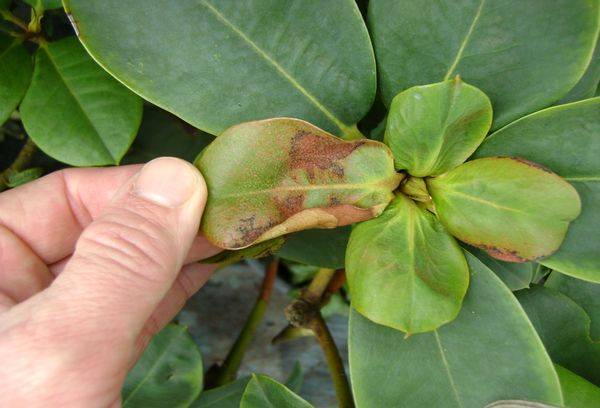

The rhododendron growing in the apartment repels small insects like ants. But some pests still attack the rose tree:
- Shaggy aphid. First it settles on young shoots, then moves to the leaves. The plant is easy to treat: wipe it with a sponge dipped in soapy water. After a week, it is allowed to spray the bush with soapy water or a pharmacy tincture of calendula.
- The tarzanemus mite is a more serious problem. It is difficult to see it with the naked eye. Signs that a tick has settled on buds, flowers and leaves: leaf plates brighten, shoots curl. The dominance of ticks leads to a lack of flowering. The popular method of dealing with the pest: prepare an infusion of wood ash (for 500 g of ash - 10 liters of water). Let the mixture sit for a day, strain and spray or wipe the bush. Repeat the procedure once a week, three treatments are enough.
When caring for rhododendrons, it must be borne in mind that their stems contain toxic substances. Wear protective gloves and restrict access to the azalea flowerpot for children and pets. If you eat a leaf, then there will be lacrimation, poisoning, vomiting. Some flowers have a strong odor, which often causes allergic reactions: skin rashes, headaches.
Let's summarize


- Indoor rhododendron or azalea is a decoratively blooming flowerpot with amazing flowers. This plant is very sensitive to leaving. Exot will not tolerate heat, prolonged drought, lack of fertilizing.
- The flower loves acidic soil, shallow pots, moderate lighting and low air temperatures.
- Caring for a flowerpot is frequent watering (the flower must live in a constantly moistened substrate), no less frequent feeding, pruning and pinching.
- This ornamental culture propagates by seeds and cuttings, and if your plant is old, it can also be divided.


Azalea (rhododendron) is rightfully on the list of the most beautiful indoor plants. Bright flowers bloom during the height of winter, creating a unique atmosphere in the room. However, this beauty is very whimsical and requires constant attention.
- 1 Who is an azalea
- 2 Planting and transplanting
- 3 Azalea care
- 4 Reproduction
- 5 Reviews of florists
- 6 Video: the nuances of growing azaleas
Watering the plant is an important point of care
Watering is also not so simple. It is necessary to increase them in case of an increase in ambient temperature, to ensure that the soil is always moist.
Azalea prefers soft water, therefore, you always need a supply of settled, but not blooming, clean water.
It is better to place the pot with the plant on a substrate of small pebbles poured into a pallet. There must always be water in the pan so that the plant receives enough moisture from its evaporation.
Who is Azalea
The homeland of the azalea (or rhododendron) is the humid high mountainous regions of the northern hemisphere. In nature, the height of these plants ranges from 10 cm to 10 m.
When in the middle of the 18th century the Swedish scientist Karl Linnaeus described 3 evergreens and 6 deciduous plants from this family, he attributed the former to rhododendrons, and the latter to azaleas. Since then, rhododendrons that are grown indoors (at home or in greenhouses) are called azaleas.
This plant is quite whimsical. However, all care efforts justify the luxurious flowers that the azalea bestows on its owners.
The stems and leaves of the plant are poisonous, you should protect the azalea from small children and pets.
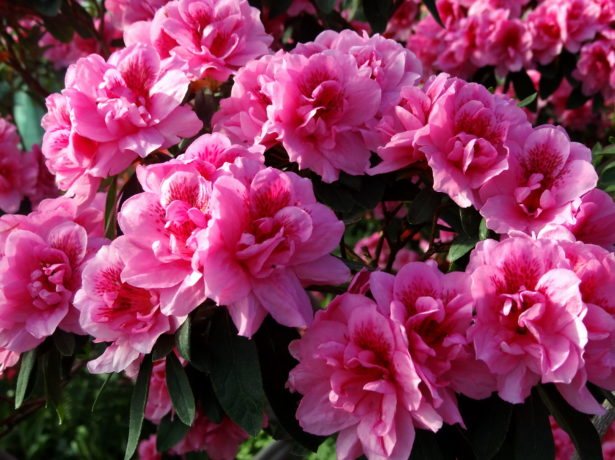

Azalea blooms very beautifully
Azalea varieties
- Indian. The main ancestor of indoor azalea varieties is a natural species of Indian rhododendron, or Simsa, which grows in humid mountain forests. He initiated many different hybrids. The flowers are large, bright, pink-red, up to 5 cm in diameter, usually arranged in 2-6 in the leaf axils. There are other colors: white, yellow, red, cream, as well as two-tone.
- Japanese. The flowers are smaller than those of the Indian. Japanese azalea is grown in the garden mainly in regions with mild and humid climates. The flower color is white, lilac, pink, red and red-orange.
- Deciduous varieties. A series of hybrid varieties descended from the Pontic azalea. These are shrubs 1–1.5 m high. The flowers are very bright: white, yellow, orange, red, pink. They bloom at the same time or before the leaves bloom. Winter-hardy, can withstand temperatures as low as -29оС.
Photo gallery: azalea varieties
Deciduous varieties of azaleas are winter hardy
Japanese azalea is grown in regions with mild and humid climates.
Indian azalea - the ancestor of the most popular varieties
Living conditions in different seasons (table)
| Season | Temperature | Lighting | Humidity |
| Spring Summer | 10-15 ° C. Such a temperature is difficult in the summer, even in central Russia. Therefore, azalea rarely blooms in summer. | Direct sunlight is unacceptable, diffused light is required. You can take it out into the garden and dig it right in the pot in partial shade. |
Rhododendron planting technology in the Urals
- You can plant rhododendron seedlings in open ground in the spring and autumn. However, in the climate of central Russia and the territories of the Urals, it is better to give preference to spring planting. So the young plant will have time to get stronger before the onset of cold weather.
- Next, you need to prepare planting holes for your rhododendrons. To do this, in the selected area, dig holes 35-40 cm deep and 50-60 cm wide.
- After that, the pits must be filled with a special soil mixture, which should consist of 8 buckets of high-moor peat, 4 buckets of loam and pine needles.
- After lightly tamping the substrate, make holes to the size of the root system of the seedlings.
- The seedlings also need to be prepared before planting. Purchased containers with plants must be filled with water for easier removal.
- Place a layer of drainage at the bottom of each well to prevent moisture stagnation at the plant roots. Small stones, gravel or broken bricks can be used as drainage.
- Carefully remove the seedlings and place them in the planting holes.
- Carefully spread the roots of the rhododendron over the planting hole and cover the seedlings with potting soil. At the same time, make sure that the root collar is at the same level with the soil or slightly higher.
- After planting, all plants are watered abundantly, and the trunk circle is carefully mulched. This is necessary to protect the plant from drying out, as well as to minimize weed growth. Peat, pine bark, needles can be used as mulch. Subsequently, this will save your plants from frosts, which are inherent in the Urals.
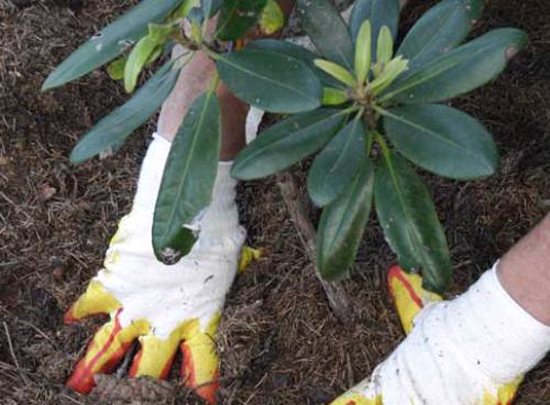

Planting and transplanting
As a rule, azalea is bought or given in bloom. After the plant has bloomed, the plant needs to be transplanted.
Indoor plants are not often found that need acidic soil with a pH of 4–4.5. For planting, it is better to buy special soil for azaleas (or acidophilic plants, i.e. those who love acidic soil), since it is rather difficult to collect it on your own. Don't forget about drainage at the bottom of the pot.
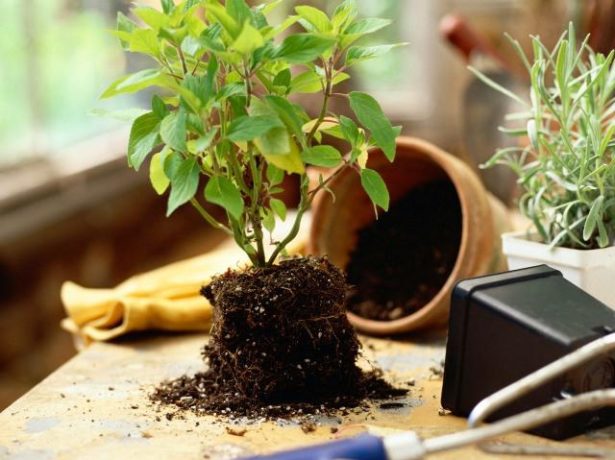

When transplanting, tender roots do not need to be freed from the ground
The root system of the azalea is shallow, so you need a pot that is shallow and wide. The roots are very delicate, so the azalea is transplanted by transshipment of an earthen coma.Then they simply add the required amount of earth to the new pot.
Azaleas up to 3 years old are transplanted annually in late spring, and older ones - 1 time in 2 or 3 years.
Photo of rhododendrons in the Urals
You can more clearly see the features of rhododendrons and options for their planting in the Urals in the photos below.
Rhododendrons are bright and beautiful plants, which many still consider exotic for our latitudes. But in fact, with the proper and correct approach, you will be able to grow these plants on your site without any problems, even in the regions of the Urals with a more severe climate.
Azalea care
Watering
The soil in the pot should always be moist - not soggy. For watering, it is ideal to use rain or melt water, in the absence of such - settled. Since azaleas love an acidic environment, you can periodically add lemon juice to the irrigation water (5-7 drops per 1 liter of water). Many gardeners use this method of watering: they pour it not into a pot at the root, but into a tray, and the plant itself “draws out” the required amount of water.
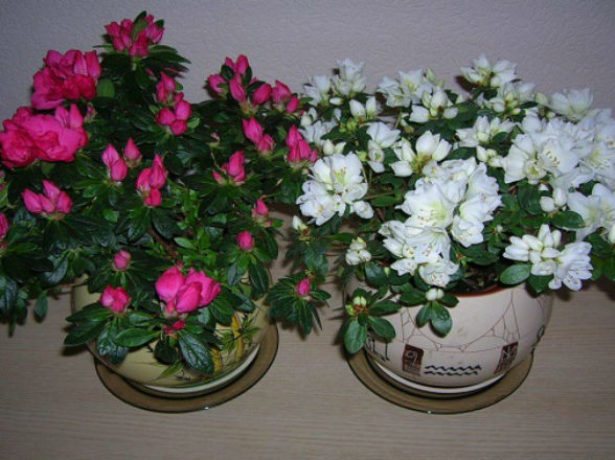

There must be a pallet under the pot of the azalea - you need to pour water into it
Top dressing
For feeding, you should use a special fertilizer for azaleas. Top dressing mode: in spring and summer - weekly (you need to prepare fertilizer in accordance with the instructions). In winter and autumn, when buds are being formed, the plant should be watered with a superphosphate solution (15 g of substance per 10 l of water).
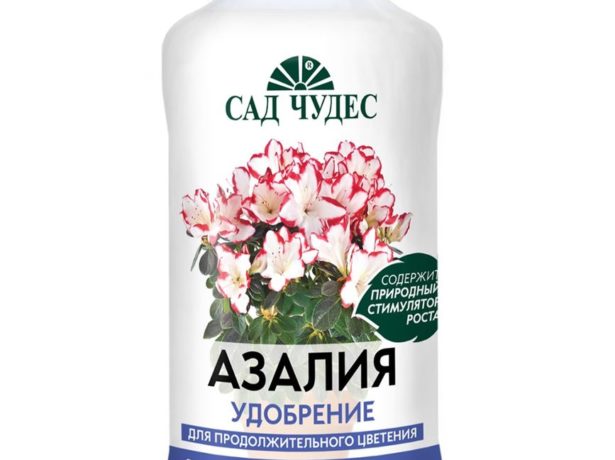

The best fertilizer for azaleas is a special fertilizer that can be purchased at a flower shop.
Pruning
Correct timely pruning of the azalea bush is the key to high-quality abundant flowering. Pruning is done in May. New shoots are pinched so that 4-5 leaves remain on them. If a shoot appears near a flower bud, it is cut off.
You can choose the type of crown - tree or bushy. To get a small tree, you need to choose the strongest branch (this will be the trunk), cut off the rest of the shoots. For stability, the trunk should be tied to a support. When the height of the shoot reaches the desired size, the tip is pinched, after which the plant begins to branch. After that, you need to sometimes turn the plant, pinching the shoots, achieving the shape of a ball.
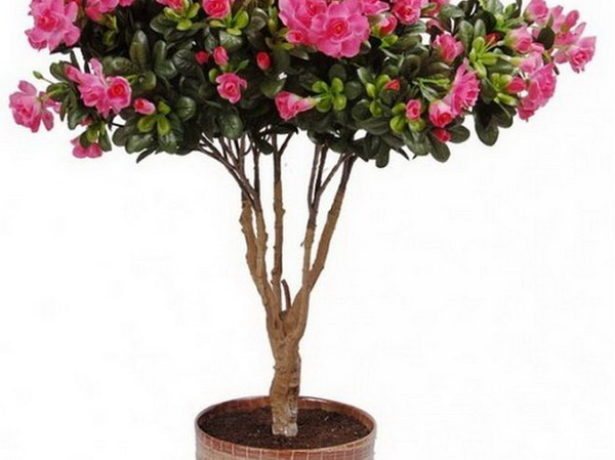

Pruning allows you to give the plant different shapes
Rhododendron in the open field
Indoor azaleas and garden rhododendrons are similar in agricultural technology:
- For planting in open ground, a shady place is chosen, preferably near a pond or stream. If there are no reservoirs on the site, then the air humidity must be maintained by placing a basin of water next to the tree. With a close occurrence of groundwater, the plant is planted on an elevated piece of land.
- A garden rhododendron needs morning watering and evening spraying, just like a room one. In dry weather, it is advisable to apply up to 10 liters of water under each bush.
- In rainy autumn weather, watering is not needed.
- The soil must not be loosened so as not to damage the roots. Weeding is done by hand only.
- In the middle lane for the winter, the rhododendron is covered with burlap. It is filmed in the spring after the snow melts. In warm areas, the rosewood hibernates without shelter.


Reproduction
Seed propagation is difficult and difficult, this method is used by professionals.
At home, the best way to propagate an azalea is by cuttings.
For reproduction, you need a semi-lignified stalk 5–8 cm long (you need to cut them from May to August).


Cuttings are harvested after flowering
- Treat the fresh cut with a root formation stimulator (Kornevin, Heteroauxin).
- Plant vertically, burying 2 cm into an acidic substrate (eg sphagnum peat).
- In the greenhouse, it is necessary to maintain a temperature of 25 ° C, the lighting should be good.
- The cuttings will take root in 1 month.
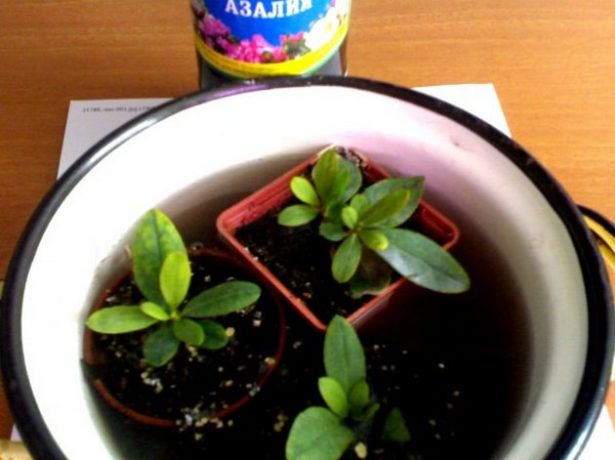

Cuttings are planted vertically, burying 2 cm into the ground
Cover with a jar or film, periodically remove the cover for watering and spraying.


For better rooting, you need to arrange a greenhouse for the cutting
Azalea grown from cuttings will delight you with its flowering in 2 years.
Video: rooting azaleas
Splitting the bush
Azalea can also be propagated by dividing the bush. When transplanting with the utmost care, a 3-4-year-old bush is divided in two and planted in another pot.
Common species and varieties
Rhododendron yellow: deciduous, pontus azalea
The most popular rhododendron species that are actively used as cultivated plants are the following:
- Rhododendron Daursky.
Places of growth: Primorye, Korea, China, Eastern Siberia, Mongolia.
Growth form: wide, spreading, semi-leafy shrub up to 4 m high. The bark is gray, the leaves are small, up to 3 cm, scaly on the underside. Differs in increased frost resistance.
Flowering lasts about a month. Blooms in large, up to 4 cm in diameter, lilac flowers. It also has a hybrid undersized garden variety with brighter and larger flowers.


Daurian view
- Rhododendron Adams.
Habitat: Far East, Tibet.
Evergreen shrub up to 2 m in height. The leaves are oblong, dark green in color, reaching 2 cm both in length and in width.
Pink flowers are small, up to 1.5 cm in diameter, but they look spectacular due to the fact that they are collected in inflorescences of 7-15 copies.
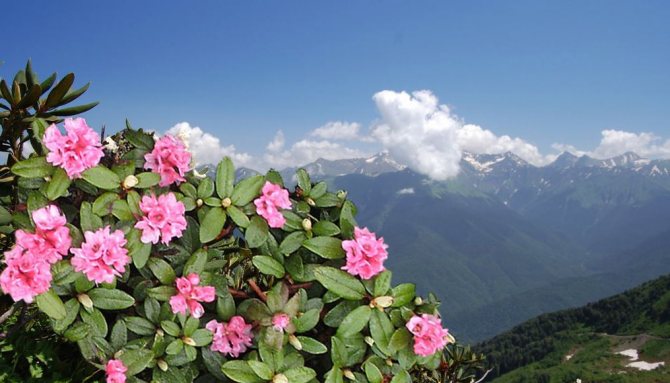

Rhododendron Adams
- Azalea Sims.
Indoor variety that blooms in spring. However, breeders have already achieved winter flowering of some hybrids of this species.
Most often it is a shrub up to 50 cm in height, less often - a standard tree stretching up to 1.5 m.
The flowers are predominantly white, pink or red. Some hybrids are salmon-colored.
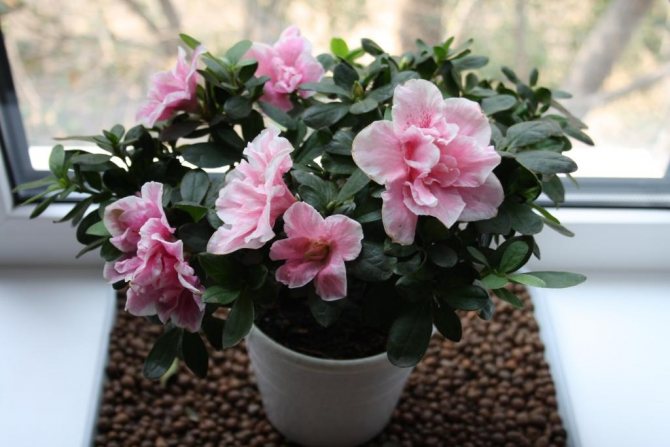

Azalea Simsa
Interesting! As soon as an azalea appears in the apartment, moths and ants immediately disappear from it.
Florist reviews
The most important rule that I have determined for myself is watering only in the pallet, and abundantly, especially in summer. Now, in preparation for flowering, he drinks water from the sump in front of our eyes in a matter of minutes. And the second is the obligatory removal of dry twigs, yellowed leaves, faded and unblown buds after flowering, and pinching the upper branches so that the plant will again delight you with its flowering. Otherwise, caring for her is not particularly difficult, the main thing is to choose the right place, she does not like dry air, does not like direct sunlight.
mona
Many friends tell me that the azalea does not take root in them, the leaves turn yellow and fall off, they cannot wait for the beginning of flowering. I usually have a pot with this flower in the kitchen, on the windowsill, under which the battery does not pass, and even then in winter we often have the battery disconnected in the kitchen. Therefore, the flower is comfortable, not hot or cold. And from May to October, the azalea stands on the loggia, as it does not tolerate the heat well, and at night it is cooler there. Azalea requires regular watering, the soil should be moist all the time. Sometimes I put the pot in the bathroom and water from the shower with fine nozzles. When the plant gets too hot, I take ice from the fridge and cover the pot.
Topolina
Azalea is a very whimsical flower. It definitely doesn't suit me, I have a huge number of plants, but I don't want an azalea. She needs constant, daily care. As a rule, we are all in a hurry and sometimes there is simply no time to take care of. And so the flower is insanely beautiful, there are so many varieties of it, they are all beautiful! My friend has azalea, but she is very meticulous and pedantic in character, she constantly fertilizes and sprays her. And that, in gratitude to her, blooms twice a year with a beautiful big hat. She never waters the azalea, she always pours water into the sump.She also does not recommend turning the plant, in general it is better not to move or rearrange. Azalea is very susceptible to various diseases.
elenaav
Preparation stages before planting rhododendron in the Urals
To obtain a beautiful and luxuriantly flowering rhododendron shrub in the not entirely favorable climate of the Urals, it is necessary to carefully prepare before planting. It is important to carefully consider the choice of a frost-resistant and suitable for this climate variety of rhododendron, as well as to find the most suitable place on your site.
Stage 1. Selection of rhododendron seedlings
The choice of a rhododendron variety suitable for central Russia will be the key to obtaining a beautiful and flowering shrub in the future. First of all, purchase seedlings of this plant only in specialized stores or agricultural firms that are professionally engaged in breeding and breeding of various plants. In such places, you can get competent advice on the conditions for planting and growing rhododendron, and you can also buy a seedling acclimatized to your region.
It is important to give preference to winter-hardy rhododendron species. This rhododendron Daurian, Schlippenbach, Canadian, Japanese and others. It is also worth buying only with a closed root system, since the root system of the plant can dry out.
Before purchasing, carefully inspect the seedling. It should be free of visible damage and signs of diseases and pests. The soil in the container must be clean and moist.


Stage 2. Choosing a place for planting rhododendron
- An important condition for the normal growth and flowering of rhododendrons is their planting in places similar to the natural growing conditions of a culture in nature.
- A bright place is suitable for rhododendrons, but protected from direct sunlight. It will be ideal if you plant seedlings among the trees in the lower tier. So the rhododendrons will receive diffused sunlight, which will contribute to the full growth of the plant.
- Full shade is also unacceptable for this culture, because rhododendrons can then stop blooming altogether.
- It is best to choose a plot for them on the north side of the house, where the sun is present only in the first half of the day.
- Perfectly rhododendrons coexist with trees, the main thing is that they do not have a superficial root system. Otherwise, they will not allow each other to develop.
- You can plant rhododendron shrubs near a pond or pond, these plants love moist air. However, it should be remembered that the place should be slightly elevated so that water does not accumulate at the roots.
- When choosing a location, consider also the fact that these plants do not like areas that are blown by winds and with the presence of drafts.


Stage 3. Selection and preparation of soil for planting
Rhododendrons are very finicky about the soil at the planting site. The substrate must be acidic and with good moisture removal. The looseness of the soil also contributes to the normal growth of the plant. If the acidity of the soil in the selected area is low, then before planting, it is necessary to add high moor peat or special preparations to increase the pH of the soil.
It is important to carefully dig up the selected area, making the soil loose and light. At the same time, add pine needles and peat, this way you will increase the acidity of the place and reduce the drying out of the substrate. In no case should you add ash, lime, dolomite flour to the soil mixture for planting. All these substances reduce the acidity of the environment.
Video: the nuances of growing azaleas
So, the azalea turned out to be a rather capricious plant. However, her tenderness and beauty justify the effort and time spent. Correctly organized temperature regime, competent watering and feeding, timely pruning and transplanting - and the bush will give the florist a wonderful abundant flowering.
Rhododendron (Latin name Rhododéndron) is a plant of the Heather family, which includes more than 600 species of evergreen deciduous and semi-deciduous shrubs or small trees. This family also includes azaleas - popular indoor and greenhouse plants.
What does a rhododendron shrub look like?
The genus Rhododendron belongs to the Heather family. In total, there are more than 800 species of representatives of this genus. Most often these are evergreen semi-deciduous / deciduous shrubs, but varieties in the form of trees are also found in nature.


Indoor rhododendron
Interesting! Many species of wild-growing rhododendron are poisonous. Moreover, all their parts are saturated with poison - stems, leaves and even flowers. An excess of substances contained in them can even lead to death.
Agrotechnics
Indoor rhododendron is a beautiful but capricious flower, its cultivation requires some knowledge and careful care. Even experienced flower growers are not always able to take into account all the whims of a flower and take care of it so that it develops well and blooms at home - in response to all efforts and care, the flower begins to wither and die.
Under natural conditions, rhododendron is able to grow in areas with a cold climate, which means that it must be grown at the same temperature as possible at home. The best temperature for a flower will be +15 degrees, in summer it can be created only with the help of an air conditioner, and in a separate room. If this is not possible, keep the flower in a room on the north or east side, in partial shade at a temperature of 20-22 degrees. It should not be placed in direct sunlight.
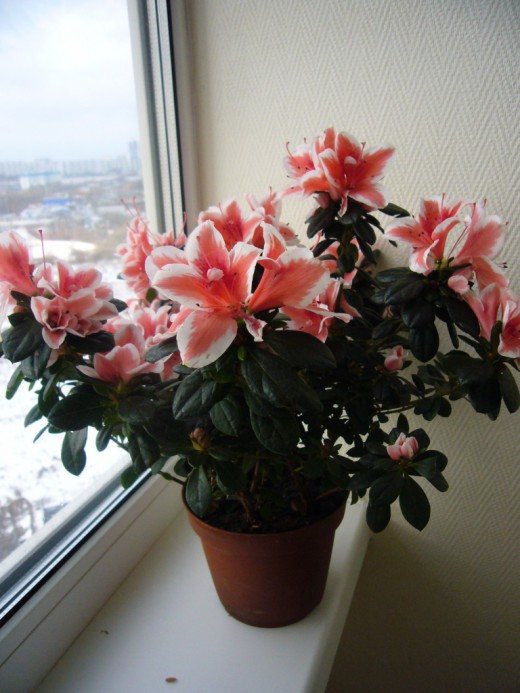

According to flower growers, rhododendron at home most often dies due to high temperature and low air humidity.
At home, in a garden or a greenhouse, caring for a rhododendron includes regular watering, but the soil should not be constantly wet, moisture stagnation is not allowed. This can cause the development of various diseases. It is best to irrigate through the pan - water is poured for 1-2 hours, after which it is drained.
The water should be clean, free of chlorine - filtered, melt or rainwater. The flower loves acid; sometimes you can add a few drops of lemon juice to the water for irrigation.
To create the necessary conditions for the humidity of the air for the rhododendron, you can put a pallet with wet moss next to it, or any container with water. During flowering, care also includes daily spraying, but the water must be sprayed from a long distance so that large drops do not fall on the flowers - this will cause brown spots on them.
Home-grown rhododendron must be fed with mineral fertilizers. Top dressing is carried out 1 time in 2-3 weeks. During the budding period, the flower is fertilized with a superphosphate solution prepared according to this recipe: 1-1.5 grams of superphosphate per 1 liter of water.
The roots of a rhododendron in a pot spread under the surface of the soil, so you need to loosen the soil in a pot very carefully and carefully. It is best to plant the flower in a ceramic pot without glaze, so that the air flows to the roots through the micropores in the walls of the pot.
No amount of care will help to grow a flower healthy and blooming if the soil for planting it is not chosen correctly. The flower loves acidic soil mixture, it is best to purchase a special soil for azaleas with an acidity in the range of 4-4.5 pH. To make the mixture loose, light and moisture permeable, sand and peat can be added to it.
A rhododendron transplant is carried out in the spring or early summer - after flowering. During transplantation, the roots are examined, dried or decaying ones are removed, obsolete peduncles and dry shoots are cut off. Young rhododendrons are transplanted every year, adults - every 2-3 years.
After one flowering, new shoots with buds begin to form in the plant, at this time you need to have time to prune - removing weak shoots. New shoots are cut off, leaving 4-5 leaves on them. The plant is poisonous, so pruning is carried out with gloves.
During flowering, wilting flowers are immediately removed so that the plant does not waste energy on the formation of seeds - thanks to this care, the flowering of the bush will be longer.
Moisture, watering, fertilization
The flowering of rhododendron is badly affected by dry air and high temperatures. Allowable temperatures up to + 19 ° C, best of all - from 10 to 15 degrees Celsius. Flowering will be long only in a cool place: at temperatures up to + 12 ° C - 2 months, at temperatures up to +19 - 2 weeks. In autumn, during bud formation, it is better to lower the temperature to + 6 ° C, and raise it just before flowering. To neutralize the effect of heating systems, you need to spray the rhododendron in the evenings with soft water at least 2 times a week.
Rhododendrons love high humidity. During the growth period, abundant watering is required; during the rest period, it is reduced to moderate. The soil in the pot must be completely moistened and not allowed to dry out. Water the plant in the morning with soft filtered or settled water, directing the stream to the root. If some of the water has not been absorbed into the soil, it must be drained from the sump after 15 minutes. So that the rhododendron is not hot, it is poured with melt water, and pieces of ice are spread around the edges of the pot. A good move is to place a container with water or wet moss next to the pot.
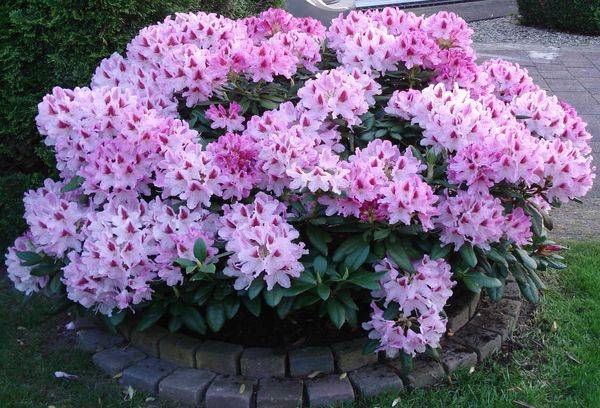

If you accidentally allow the soil to dry out in a pot with rhododendron, you will need resuscitation. First way: put the pot in water for 4 hours. During this time, the plant and soil are sufficiently saturated with moisture. After 3-4 days, regular watering resumes. The second way is to arrange souls for the plant. Water temperature - up to + 30 ° C.
Tip Water the plant only with soft, settled water.
The peculiarity of caring for a rose tree is daily feeding. Liquid complex fertilizer is sold especially for rhododendron. During each watering, a certain amount of fertilizer is added to the water. This amount is calculated by dividing the monthly rate by the number of waterings. When the buds are formed, it will not be superfluous to add classic dressings, making them 1 time in 20 days.
Types of home rhododendron
|
|
|
|
|
Diseases and pests
The most common problems with a beautiful azalea:
- Chlorosis azalea leaves begin due to too hard water or improper composition of the substrate. It is necessary to change the watering conditions - water should be watered with slightly acidified water. It is advisable to feed the flower with iron chelate. If the substrate is not suitable, it will need to be replaced.
- Late blight - decay of the root, this disease gradually spreads to the branches and leaves. It is necessary to adjust the air permeability of the substrate. Spraying the leaves with a phytoverm will help.
- Necrosis azalea begins to ache from sharp freezing, from drafts. The leaves turn brown. It is necessary to adjust the temperature and rearrange the azalea in a brighter place, avoiding the influence of drafts and air conditioners.
The most dangerous pests for azaleas:
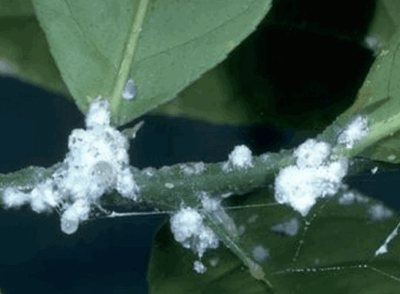

Strawberry mite Is the most dangerous pest. He eats flowers, buds, young leaves curl, shrink and fall off. The flower may die. Will save fitoverm or neoron. It will require processing 3 - 4 times with an interval of 8 - 9 days. You need to process the pot, and the window, and the window sill, this pest is very tenacious, it is difficult to remove it.- Spider mite braids branches and leaves with a thin cobweb, feeds on sap, the leaves turn brown-gray and fall off. If the disease is not started, washing the leaves with soapy water will help. Can be sprayed with actellik solution: 2 ml per liter of water.
- Moth azalea twists the leaves into a tube. Leaves dry and fall off.Caterpillars quickly crawl onto healthy leaves, quickly destroying them. Sulfur helps with this ailment.
- Mealybugs bend the leaves, affect young shoots and the flowers themselves. A warm shower and spraying with a solution of any insecticide - 1 ml per liter of water is very useful here.
- Rhododendra bugs Are the main pests of azaleas. They leave ugly age spots on the leaves, lay eggs on the inner surface of the leaves. Diazin treatment will be required.
Azalea pests and symptoms of their appearance, as well as ways to deal with them in this video:
Now, when friends give you this beautiful flower in a pot, you will not feel the feeling of shyness of a novice gardener just because you do not know how to properly care for it. Azalea is a sophisticated flower that needs special care, proper watering and high humidity. The flower is very delicate, susceptible to various diseases and pests. But all the efforts and troubles will be paid for by the chic, exquisite flowering of the beautiful azalea.
How to choose soil
For rhododendrons, it is best to buy a ready-made substrate: for azaleas or heather.
The soil mixture must be slightly acidic, it must contain coniferous soil, peat, sand, nutritional supplements.
- Option one. It is better for novice gardeners to buy ready-made soil mixture. Soil for azaleas should contain peat, sand, drainage, mineral additives, vermicompost, coniferous and leafy soil.
- Option two. If you wish, you can prepare the soil mixture yourself. It should contain in equal proportions heather, leafy soil, sand, high moor peat, crushed pine bark. The soil is fertilized with mineral and organic additives. Usually, 5 grams of top dressing is taken for one liter of water.
- Option three. In equal proportions, take coniferous, leafy soil, sand, peat. For loosening, add coconut flakes or crushed coniferous sawdust. The land for azaleas must be disinfected and ignited at high temperatures.
When and how rhododendron blooms
Azalea blooms only for 3-4 years of its life, therefore, if a young plant does not bloom, do not worry and think that something is going wrong. You just need to wait for him to fully mature.
Types of flowers
Azalea flowers can be simple, double and semi-double, most often they are large, located one by one, the smaller ones are usually collected in lush inflorescences.
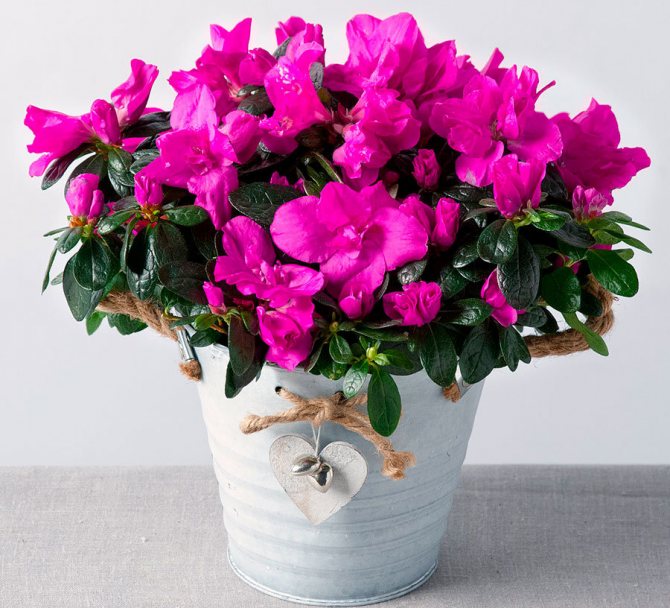

Azalea with simple flowers
On average, their diameter is 3-5 cm. Flowers of some varieties have a pleasant delicate smell.


Azalea with double flowers
Flower shapes
There are several options for the shape of rhododendron flowers, they depend solely on the species and variety.
The following forms are distinguished:
- funnel-shaped;
- tubular;
- bell-shaped;
- wheel-shaped.
Flowering period
The flowering period directly depends on the plant variety. There are varieties that bloom in winter, in November-December, and there are those that bloom in February-April.
Despite the fact that the splendor of the rhododendron during the flowering period defies description and wants to admire them as long as possible, it does not bloom for long - no more than 1.5 months at home. Unfortunately, the plant blooms only once a year.
Changes in care during flowering
No changes can be made for the rhododendron during its flowering period. But if there is a desire to slightly extend this period, you can gradually reduce the temperature in the room where the plant is located.
Important! During the period of budding and flowering, the pot cannot be transferred to a new place, this threatens to drop the buds or freeze their development.
Temperature
For species blooming in the garden, direct sunlight is dangerous, so we plant rhododendron along fence or under gazebo roof... Indoor views are more difficult. Azalea loves cool and absent-minded shine... For information on how to maintain a comfortable + 18-20 degrees in summer, read the landing section.
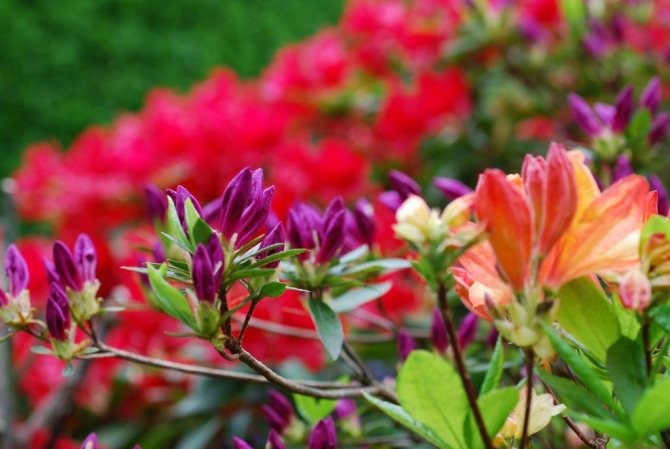

Rhododendron is afraid of direct sunlight
Shelter for the winter
Since the winter in the northern region is very harsh, even frost-resistant varieties of flowering shrubs may not survive it. Therefore, every autumn they must be covered for the winter. This should be done as soon as the temperature has dropped to zero.
Tags: planting, rhododendron, siberia, care
About
«Previous post
Site selection and soil requirements
Rhododendrons thrive in shaded areas where oblique rays of sunlight penetrate. The optimal area is considered to be on the northern side of the site, located near the house or next to tall trees. Also, a place near water bodies is suitable for landing, since the culture loves moist air.


Rhododendrons can grow exclusively in acidic and loose soil. Therefore, before planting in the ground, it will be necessary to add peat with coniferous needles or another substrate that will create optimal conditions for the development of the shrub.
Medicinal properties
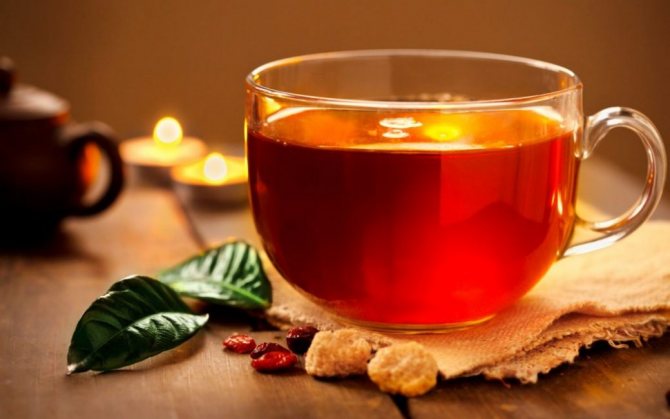

Flower tea helps with colds
Rhododendron contains ascorbic acid in large quantities, tannins, essential oils, phytoncides, rutin, tannins, arbutin, andromedotoxin, ericolin, and many other elements that make it possible to put it in a number of medicinal plants.
Caucasian, golden, Daurian, Indian rhododendron have clearly expressed medicinal properties.
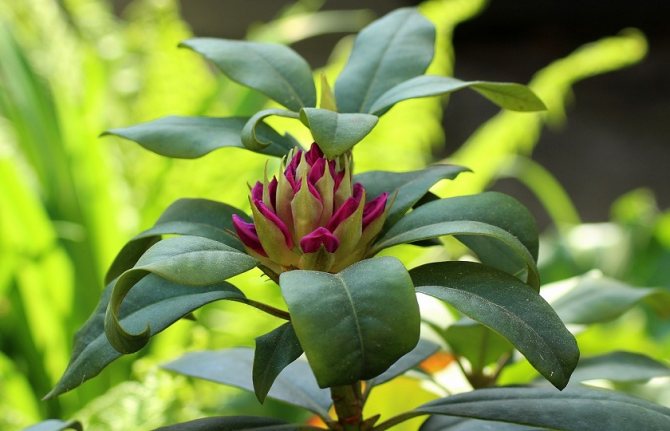

1 bactericidal
2 pain reliever
3soothing
4 antipyretic
5 sweat
- Bactericidal properties are used in the fight against staphylococci, streptococci, pathogenic microorganisms.
- Decoction of flowers helps in the treatment of diseases of the gastrointestinal tract. It is part of a diuretic drug for urolithiasis.
- Rubbing tinctures of leaves and flowers into sore spots helps with polyarthritis, osteochondrosis, neuralgia, sciatica. The ability to remove fluid from the body is used in many diseases, as it helps to cope with edema, which contributes to better health. Used to treat diseases of the heart and blood vessels, hypertension.
- Preparations from the leaves alleviate the condition of bronchial asthma, epilepsy, soften dry cough, have a beneficial effect on the lungs, relieve fever. The calming effect improves falling asleep, relieves irritability, nervousness.
- An infusion of leaves is used as a douching for uterine erosion.
- Flower tea relieves pain in the head, throat. Effective for colds.
- Alcohol tincture on flowers and leaves is taken in case of poisoning with mercury vapor, inflammation of the mucous membrane.
Since rhododendron contains a small amount of toxic elements, preparations from it are contraindicated:
- Nursing mothers
- Women in position
- Patients with acute renal failure
The content of a large amount of essential oils makes rhododendron in demand in the perfume industry. Extracts from the plant are used to make perfume.
Preparing for winter in the garden
Most types of rhododendrons for the winter need to be covered:
- the trunk circle is covered with a thick layer of leaf litter;
- over the bush install the frame, on which agrofibre with a density of 60 g / m2 is pulled;
- when frosts are established, a layer of snow should be sketched on top of the shelter.
The shelter is removed when the temperature becomes above 0 degrees.
If you take into account all the requirements of a rhododendron when planting, and create conditions suitable for its growth and flowering, then caring for it will not be difficult. The most important thing to do is water it, and water the foliage with water in hot weather. With good care, this shrub can live in one place for more than 25 years.
Briefly about the history of appearance
The name Rhododendron is translated as "rose tree" (from the Greek "rhodon" - rose and "dendron" - tree).
Rhododendron Katevbinsky Grandiflorum
According to one of the legends widespread in Europe, it is believed that once a terrible fire broke out in the forest.The elves in a hurry tried to escape from him, they flew to the foot of the mountain and, tired, asked to sleep in the new forest. But no one wanted to accept strangers, except for one bush.
In the morning, the rested elves decided to thank him for his hospitality and presented him with flowers of incredible beauty. This is how this wonderful flower appeared.
Interesting! In Russia, rhododendron appeared only at the beginning of the twentieth century. He was brought as a gift to the king. Initially, it was grown only in the royal gardens and greenhouses.
When to plant a garden flower
Planting time depends on which root system of the rhododendron is open or closed.
Rhododendron, whose roots are in the container, can be transplanted to a permanent growing site at any time. It is important that the earthen lump does not crumble during transplantation. The day before planting, it is abundantly moistened with water, and the edges of the soil are carefully separated from the walls of the container with a thin sharp knife.
Rodendron sapling open-rooted it takes root best in autumn, when the weather is cool and the air is humid. In the spring, you can also plant such a seedling, but in order for it to take root, it will have to be watered often and sprayed daily.
A seedling with a closed root system can be replanted at any time
Virulence
Rhododendrons are very cunning. These beautiful plants are dangerous. Flower nectar and pollen can be deadly poisonous not only to animals, but also to humans. There is a Greek legend according to which soldiers during a military campaign were poisoned with honey collected by bees from Pontic or Yellow rhododendrons. The poisoning was narcotic. The honey from these plants can have a laxative or hallucinogenic effect.
Azaleas are toxic to animals. They can die by eating a few leaves. The danger to humans is the andromedotoxin glycoside contained in rhododendrons. This substance acts on the central nervous system: first exciting, and after a while - depressing. May cause death of a person. The poisonous substance is present in leaves, stems, flowers, nectar and collected honey.
The main characteristics of the plant
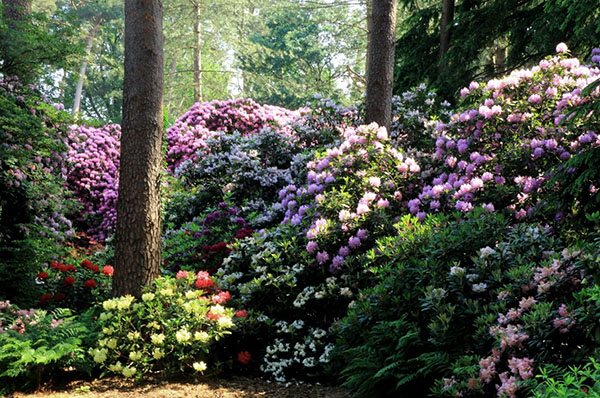

Rhododendron belongs to garden ceremonial crops, suitable for landscape design. Under natural conditions, it grows in the USA, Japan, China, India, preferring the slopes and coasts of water bodies. Among the known species, there are tall and low-growing trees (evergreen, deciduous), shrubs and semi-shrubs. They differ in height, splendor and flowering time, shape, size and color of buds, as well as preferred climatic conditions.
Indoor azaleas are also referred to as rhododendrons. They have similarities in appearance and similar requirements for growing conditions.
| Characteristic | Description |
| Genus name | Rhododéndron (lat.); |
| Family | Heather; |
| Views | biologists have more than 600 different species; |
| Plant height | from 30 cm to 30 m; |
| Flowers size | from 1 to 20 cm; |
| Bud shape | funnel-shaped, bell-shaped, tubular, wheel-shaped; |
| Color | white, pink, lilac, red, crimson, yellow, orange; |
| Root system type | surface; |
| Ground requirements | sour, nutritious; |
| Illumination | partial shade, diffused light is preferred; |
| Humidity | high (preferably planted near fountains, reservoirs); |
| Landing features | the size of the planting pit is 50 cm by 50 cm, the presence of a drainage layer, mulching of the peri-stem circle; |
| Reproduction methods | seeds, layering, cuttings. |
